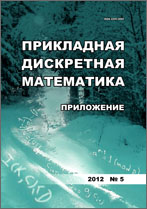|
|
Prikladnaya Diskretnaya Matematika. Supplement, 2012, Issue 5, Pages 51–53
(Mi pdma35)
|
 |
|
 |
Mathematical Methods of Cryptography and Steganography
Differential equations for hash functions from MDx-family
S. D. Loshkaryov
Faculty of Computational Mathematics and Cybernetics, M. V. Lomonosov Moscow State University, Moscow
Abstract:
Creating a hash function cryptographers almost never prove the selection of algorithmic blocks, the order of blocks. The hash-function HAVAL proposed in 1992 is probably the only exception from this rule.This hash-function is constructed of blocks with specific properties such as strong independence of output bits, strong avalanche effect, 0-1 balance and others for Boolean functions, and the result hash function was proposed to be cryptographically strong. But time had shown that it is not true. The papers, proposing other popular hash-functions such as MD4, MD5, SHA-0, SHA-1, SHA-2, RIPEMD, GOST 34.11-94 and others, do not contain any proof for choice of elements. The algorithms used in construction of the hash-family of MDx contain constant values, addition modulo $2^{32}$, rotations and primitive Boolean functions, chosen by the author. The cryptanalytics almost had not undertaken yet any attempts to prove the choice of elements and if it is possible to change them to improve the cryptographic properties of the algorithm. The main target of this paper is an analysis of how primitive Boolean functions and rotations influence the resistance of MD5 to differential attacks.
Citation:
S. D. Loshkaryov, “Differential equations for hash functions from MDx-family”, Prikl. Diskr. Mat. Suppl., 2012, no. 5, 51–53
Linking options:
https://www.mathnet.ru/eng/pdma35 https://www.mathnet.ru/eng/pdma/y2012/i5/p51
|

|




 Contact us:
Contact us: Terms of Use
Terms of Use
 Registration to the website
Registration to the website Logotypes
Logotypes








 Citation in format
Citation in format 